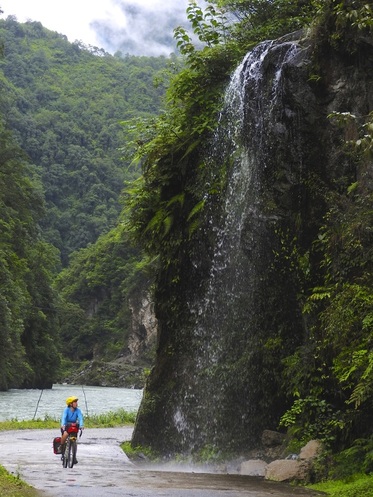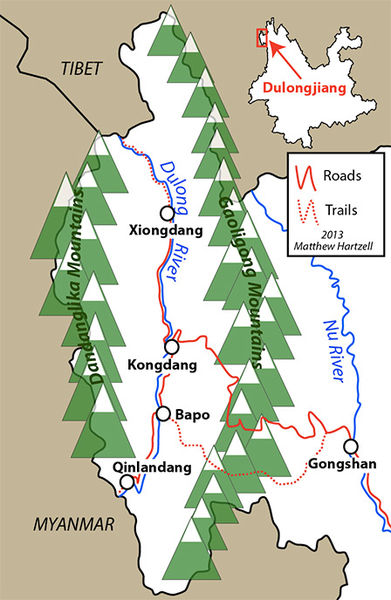
We had departed Bingzoulao in the upper Nujiang Valley that morning, our efforts to get going earlier than usual thwarted by the temptation of an unexpected street market and saying goodbye to our cycling companion Will over a dumpling breakfast. It was afternoon by the time we made the turnoff and began a gradual 25-mile long climb on an amazingly smooth, newly-paved, but traffic-free road. We weren't even sure if the Dulong Valley was open to foreigners, having heard accounts of restricted access within the last few years. At the only checkpoint we encountered, we ducked under a barricade and waved to the teenage police that we spotted through the open doorway of an adjacent building. They didn't bother to get up from the couches they were lounging on, so we figured we were in the clear.
The next morning was no less foggy and rainy, so we slept in and took a leisurely walk around the color-coordinated town adorned with contrived ethnic embellishments. While searching for information on this valley, we came across one blog that perfectly described Kongdang as akin to the look of an Olympic Village. We took these efforts as a sign that Dulong is poised for promotion as a domestic tourism destination, a hunch that was only strengthened when we left Kongdang that afternoon and encountered village after uniform village, with a Chinese flag flying above every identical house.
Apparently, the government has been consolidating the traditionally dispersed population of Dulong by building housing with modern amenities at little to no cost to the occupants. This offer is enhanced by providing a nice subsidy simply to reside in the development and do a whole lot of, well, nothing. While I can only speculate about the motivations for this generous assistance, it seems to be the perfect combination of placating minority groups with an easy life while making their ethnicity an easily accessible attraction for urban Han seeking an exotic vacation. Does this ring any bells? Perhaps Tibetan ones?
Just twelve miles down the road, we too became recipients of the government’s generosity when we stopped in search of a restaurant in Bapo. An employee of the local development office informed us there was no restaurant but invited us to “eat with many people.” He also mentioned something about a dance happening later that night. We were intrigued, so he arranged for us to stay in a spare room of an old lady’s house, unfortunately at a price more than double our usual guesthouse rate.
While we were getting situated in our room, the entire village gathered for a meeting in the government office complex. We wandered over as the meeting ended and people filled the adjacent courtyard. A large sound system began blaring music and beers were cracked open. We grabbed a spot on a concrete ledge and watched the celebration unfold. Small groups frequently approached us to cheers, but for what occasion we had no idea. A long row of tables was set up in the middle of the courtyard, then covered with tremendous bowls of rice and pots of various meat dishes. A serve-yourself frenzy ensued and brought clarity to our host’s phrase “eat with many people.” When everyone had their fill, the leftovers were divied up and carried off to nearby homes. Cases upon cases of beer replaced the food on the tables and the party got started in earnest with villagers beginning to dance in a revolving circle around the beer centerpiece. Of course, it wasn’t long before we were beckoned in to the circle, but it was a long while before we caught on to the repetitive but complicated steps. Somehow, the more beer we drank, the better we danced though!
When we took a break from the dancing, we met a fellow visiting from Indonesia who explained that we were in the midst of honoring the 94th Anniversary of the Founding of Communist China. We wondered how much of the local Dulong people’s enthusiasm was rooted in patriotic pride versus the monument of free beer they were dancing around, considering they have only recently been brought into the fold of modern political events. As for us, we would soon be missing the fireworks and barbeques of Independence Day back home, so why not raise a glass to Chairman Mao in the meanwhile? The Communist Party was buying all the rounds, after all.
A return of the rain shifted the dancing indoors and provided the opportunity to transition from the traditional Dulong dances to a club-style free for all. We particularly enjoyed seeing some of the Dulong men wearing traditional colorful striped vests getting into it. As entertaining as this was, we slipped away for some rest before too long. Even as we headed out late the next morning, we encountered a few dedicated comrades for whom the celebration was still going strong.
The ride was absolutely gorgeous as we continued south for fifteen winding miles to Qinlandang. We checked in to the only guesthouse in town, a pepto-pink concrete monstrosity that did not fit in with the wood cabin-style residences surrounding it. We have stayed in plenty of hotels that did not have a bathroom in the room, but this was the first place we stayed that did not have a bathroom in the entire building. We were directed to the public toilets somewhat close by, which were simply tiled trenches without running water.
We continued past town a few miles along the river to the base of Moon Falls, thundering down the hillside with an impressive volume from all of the recent rain. We had hoped to ride to the Burmese border just for fun, but the waterfall was pounding the road, which had turned to a rough dirt track at the edge of town. While we were admiring its force, a few guys sporting ponchos and galoshes popped out of the forest after having traversed a route somewhere above the falls. They simply smiled at us and continued on their way on foot. We presumed they were Burmese crossing the border for work, or trade, or both. Then an SUV zoomed by and drove into falls without pause, that is until it got stuck midway through. We could see the reverse lights through the flow, but the vehicle was not budging. Eventually a guy got out in nothing but his "reddy-tighties" and got pummeled while placing rocks under the tires. It was amazing that the engine didn't get flooded while getting out of that mess.
That was an illustrative enough lesson for us not to be tempted to cross, so we rode back to town. We found a restaurant with an official looking sign outside, but upon poking our heads inside we were welcomed into a cozy home. They did had the ubiquitous display case refrigerator, which effectively convinced us that it really was a restaurant. We sipped tea and warmed up sitting by the fire that was also cooking up the veggies we pointed to in said refrigerator.
The oldest generations of Dulong women bear the markings of tradition in the form of elaborate facial tattoos. Since the practice was abolished in 1949 with the formation of the People's Republic of China, less than 28 women with them are still alive. Even those women are not sure of the tradition's origin. An article explains, "Some experts have posited that the tattoos were to make the women less attractive, lest they be taken as slaves or raped by enemies during conflicts between the Dulong and other ethnic tribes. Some say that it marked a girl's transition to womanhood, while still others believe that it was a sign to differentiate various clans or families. Others hold that the Dulong people regarded tattooing as a beauty enhancer and a way to exorcise evil spirits."
As Kongdang is located in the middle of the north-south oriented valley, we were of course curious to explore the road to the north. The terrain was more gentle heading this direction the river was more mellow accordingly. We made it as far as the road was paved, making Xiongdang village the turn around point of our day ride after we ate fried rice (with chicken feet on the side) in an informal restaurant. Had we kept going, we would have eventually reached Tibet and somewhere within it the glacial source of the Dulong River. A dream adventure for another time and another political regime.
We had a gradual goodbye with Dulong as we slowly climbed out of the valley on the road we rode down on a rainy pitch dark night. The drizzle had finally subsided, but low clouds still clung to the contours of the hills and we fully appreciated what we had initially missed. After 4,000 feet of elevation gain over twenty miles, we officially left the domain of Dulong at the crazy five-mile long tunnel. It still felt frigidly cold inside, even though we were pedaling uphill to get through it. On the other side, we stopped to take in new views of that had not been visible when rode through before. It was a beautiful descent, but after just a few days in Dulong, somehow Nujiang seemed almost ordinary, and believe me, the Nujiang is far from ordinary. Oh, and the hot sun overhead in a bright blue sky was nearly blinding.


 RSS Feed
RSS Feed
